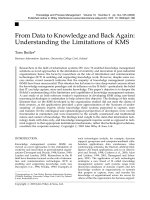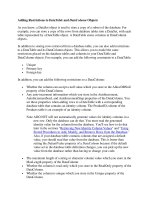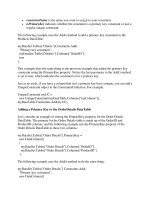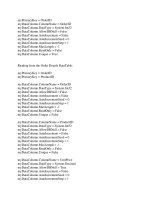Tài liệu From Data to Knowledge and Back Again: Understanding the Limitations of KMS pdf
Bạn đang xem bản rút gọn của tài liệu. Xem và tải ngay bản đầy đủ của tài liệu tại đây (127.09 KB, 12 trang )
&
From Data to Knowledge and Back Again:
Understanding the Limitations of KMS
Tom Butler*
Business Information Systems, University College Cork, Ireland
Researchers in the field of information systems (IS) view IT-enabled knowledge management
solutions as novel approaches to the stimulation of creativity and innovation in post-industrial
organizations; hence, the focus by researchers on the role of information and communication
technologies (ICT) in enabling and supporting knowledge work. However, despite some suc-
cess stories, recent research indicates that the majority of knowledge management systems
(KMS) have been unsuccessful. This situation has led some to voice deep-seated concerns about
the knowledge management paradigm and its influence on the IS field—particularly the belief
that IT can help capture, store and transfer knowledge. This paper’s objective is to deepen the
IS field’s understanding of the limitations and capabilities of knowledge management systems.
A case study of an Irish software vendor’s experiences in developing KMS using case-based
reasoning technologies is undertaken to help achieve this objective. The findings of this study
illustrate that: (a) the KMS developed in the organization studied did not meet the claims of
their creators, as the applications provided a poor approximation of the ‘horizons of under-
standing’ of domain experts whose knowledge these systems purported to capture, store
and transfer; (b) the ontological and epistemological perspectives of developers were overtly
functionalist in orientation and were insensitive to the socially constructed and institutional
nature and context of knowledge. The findings lend weight to the claim that information tech-
nology deals with data only, and knowledge management requires social as opposed to tech-
nical support, in that appropriate institutional mechanisms, rather that technological solutions,
constitute the corporate memory. Copyright # 2003 John Wiley & Sons, Ltd.
INTRODUCTION
Knowledge management systems (KMS) are
viewed as novel approaches to the stimulation of
creativity and innovation in post-industrial organi-
zations (Davenport and Pruzak, 1998; Kanter, 1999;
Laudon and Laudon, 2000). Researchers in the IS
field have therefore focused on the role of informa-
tion and communication technologies (ICT) in
enabling and supporting knowledge work (see
Davenport et al., 1996; Sviokla, 1996). Examples of
such technologies include, for example, decision
support, groupware and computer-mediated colla-
boration applications, data warehouses, video
conferencing, intranets, the Internet, artificial intel-
ligence (AI) based applications, and so on (Daven-
port and Prusak, 1998; Carlsson et al., 2000; Alavi
and Leidner, 1999, 2001; Damsgaard and Schee-
pers, 2001). The application of such technologies
underpins a new breed of IS called knowledge
management systems: such systems range from
directories/databases of domain experts and key
knowledge workers in organizations, to systems
that purport to capture, store, and transfer the
knowledge of organizational actors for access by
others within the organization for decision support.
Knowledge and Process Management Volume 10 Number 3 pp 144–155 (2003)
Published online in Wiley InterScience (www.interscience.wiley.com). DOI: 10.1002/kpm.180
Copyright # 2003 John Wiley & Sons, Ltd.
*Correspondence to: Tom Butler, Business Information Systems,
O’Rahilly Building, University College Cork, Cork City, Ireland.
E-mail: tbutler@afis.ucc.ie
Recent research indicates that many knowledge
management systems are unsuccessful (see
Schultze and Boland, 2000), with Storey and
Barnett (2000) reporting failure rates of over 80%;
nevertheless, Davenport et al. (1996) catalogue a
number of success stories. While there is much
debate, theorizing, and writing of a normative nat-
ure on the topic, there is a paucity of in-depth
empirical research on the development and imple-
mentation of KMS. Inconclusive findings and a
dearth of empirical evidence has led some to voice
deep-seated concerns about the knowledge man-
agement paradigm and its influence on the IS field.
Of particular concern are the belief that KMS con-
stitute a new type of information system (as
opposed to DSS, GDSS, EIS and expert systems,
etc.) and the claims that they can capture, store,
and transfer knowledge within organizational con-
texts.
To better understand the limitations and capabil-
ities of knowledge management systems, this study
focuses on one of the AI-based technologies
employed to develop KMS—case-based reasoning
(CBR) technology. This choice is purposive in that
strong claims are made concerning CBR’s ability to
capture knowledge for decision support in organi-
zations. Consequently, this paper reports on the
experiences of an Irish software vendor—Interac-
tive Multimedia Systems (IMS)—in developing
information systems using CBR technologies to
capture, transfer, and deliver knowledge in organi-
zations. The findings of this study illustrate that the
knowledge-management technologies developed at
IMS did not meet the claims of their creators, as the
case-based reasoning applications described pro-
vided a poor approximation of the ‘horizons of
understanding’ of domain experts whose knowl-
edge they purportedly captured and transferred.
Accordingly, the use of these applications was
restricted to relatively unambiguous and rudimen-
tary situations where problem scenarios and
responses tended to be well-defined. This supports
the claim that information technology deals with
data only and suggests that knowledge manage-
ment requires social as opposed to technical sup-
port, in that appropriate institutional mechanisms,
rather than technological solutions, constitute a
firm’s ‘corporate memory’.
The remainder of this paper is structured as fol-
lows: Section 2 briefly reviews extant thought on
knowledge management in the IS field and con-
cludes that there is a need to critically evaluate
the empirical evidence for knowledge management
systems; Section 3 presents a short overview of the
research approach employed; Section 4 describes
the case report and study findings; and, finally,
Section 5 provides a discussion of the findings
and offers several conclusions.
KNOWLEDGE MANAGEMENT
OR DATA PROCESSING SYSTEMS?
The IS field is concerned with the development,
implementation and use of systems to informate
organizational actors and automate business pro-
cesses (Checkland and Howell, 1998). However,
Boland et al. (1994) argue that information systems
have been less successful at informating—that is,
supporting the cognition and decision-making of
organizational actors—than in automating—that
is, removing all opportunities for individual deci-
sion making and learning. The problem here lies
in the prevailing image of organizational actors
as decision makers governed by bounded rational-
ity (Introna, 1997), the root cause of which is the
predominant influence of economics on the social
sciences (Pfeffer, 1994, 1995). This has, in conjunc-
tion with the positivist influence of computer
science and mathematics, resulted in a chiefly
functionalist orientation of IS practitioners toward
systems development and the social and organiza-
tional context in which it occurs (Hirschheim and
Klein, 1989). Boland (1979) points out that such per-
spectives have led to the design of systems with
decision-support models that operate on narrow
sets of data. According to Pentland (1995, p. 2),
the limitations of this narrow view ‘can be attributed,
in part, to a lack of attention to the fundamentals of the
phenomenon in question: the socially constructed, dis-
tributed, and embedded nature of knowledge, and the
process by which it changes.’ Pentland’s paper was
one of several which marked a change in emphasis
from IS support for organizational learning to orga-
nizational knowledge systems. This reflected a
loosening of functionalist and foundational influ-
ences through the integration of alternative per-
spectives coupled with a paradigmatic shift in
organizational theory and related fields. This
change in orientation is particularly notable in a
paper by Boland and Tenkasi (1995) which focuses
on IT support for ‘communities of knowing.’ Hence,
in the mid-to-late 1990s, researchers began to focus
on how knowledge could be created, organized,
stored, retrieved, transferred and applied in orga-
nizations (Pentland, 1995; Davenport and Prusak,
1998; Nonaka and Konno, 1998).
While research on organizational learning was
certainly influential on the IS field’s new-found
interest in knowledge, it must be noted that
researchers in the field and the related discipline
of computer science previously focused on
Knowledge and Process Management
Understanding the Limitations of KMS 145
information and, implicitly, knowledge, albeit nar-
rowly, in the context of developing expert, decision
support, and executive information systems.
Another theoretical influence on the IS field origi-
nated in the knowledge-based view of the firm,
which emerged from the resource-based view in
institutional economics. Also significant was the
focus on knowledge in strategic management and
organization theory (Carlsson, 2001). Nevertheless,
while strong on theory and normative advice,
knowledge management practice has generally
failed to deliver, especially when it comes to provid-
ing knowledge management systems. Possible rea-
sons for this are offered by Butler (2000) and
Broendsted and Elkjaer (2001) who, following
Boland et al. (1994) and Pentland (1995), recognize
the narrow focus of extant perspectives on knowl-
edge and recommend a view of learning that
includes social context and processes. These points
are echoed by several commentators who have cau-
tioned against an over-reliance on IT solutions at
the expense of social and cultural dimensions to
knowledge and its management (Davenport and
Prusak, 1998; O’Dell and Grayson, 1998; Swan et al.,
1999; McDermott, 1999).
The mixed results reported in the studies men-
tioned indicate a fundamental problem in the IS
field’s approach to the concept of knowledge. Sup-
port for this assertion comes from Galliers and
Newell (2001) who voice deep-seated concerns
about the knowledge-management paradigm and
its influence on the IS field. Galliers and Newell
(2001, p. 609) argue that:
Knowledge Management [is] the most recent in a long
line of fads and fashions embraced by the Information
Systems community that have little to offer. Rather,
we argue for a refocusing of our attention back on
the management of data, since IT processes data—
not information and certainly not knowledge.
This argument reflects views expressed in previous
research—see Swan et al. (1999), Butler (2000), and
Spiegler (2000). Hence, as indicated, there is a need
to critically evaluate the empirical evidence for
knowledge management systems. There is also an
imperative to examine the ‘world views’ of develo-
pers and those who promote so-called knowledge
management technologies. This, then, provides
this study’s motivation.
A CASE-BASED RESEARCH STRATEGY
A constructivist research approach was adopted for
the present study (Guba and Lincoln, 1994).
Accordingly, a qualitative, interpretive, case-based
research strategy was implemented (see Lincoln
and Guba, 1985 and Butler, 1998). This strategy
involved an instrumental case study on knowledge-
management technologies developed at Interactive
Multimedia Systems (IMS) of Dublin, Ireland
(Stake, 1995). An article in the Irish Sunday Busi-
ness Post in early 1998 drew the researcher’s atten-
tion to a small-to-medium sized Dublin-based
software vendor, Interactive Multimedia Systems,
and its reported competencies in developing corpo-
rate memory and related knowledge-management
systems. The article claimed that the company
had developed a state-of-the-art knowledge-man-
agement system for Analog Devices, Inc., of Boston
in the USA. Given the growing interest in knowl-
edge management at this time and the paucity of
theoretically grounded empirical research, IMS
presented itself as an interesting case with which
to examine the reality of knowledge-management
systems. Purposeful sampling was employed
throughout. Research was conducted in the sum-
mer of 1998 at three sites, two in Ireland and one
in the USA. The US-site visit afforded the research-
er an opportunity to evaluate a knowledge-man-
agement application developed by IMS for
Analog Devices, Inc. Eleven social actors partici-
pated in the study. The general interview guide
approach was chosen as being the most appropri-
ate for this particular study—here, a semi-struc-
tured interview strategy was chosen (Patton,
1990)—and each interview was tape-recorded
and was up to two hours in length. A wealth of
documentary evidence was also gathered, and a
significant amount of data accrued from informal
conversations and observations while on-site at
the research locations. The qualitative data analysis
methods of content and constant comparative ana-
lysis were employed to analyse the data (Patton,
1990). Finally, the case report approach was used
to write up the research findings (Stake, 1995).
APPLYING KNOWLEDGE
MANAGEMENT TECHNOLOGY AT
INTERACTIVE MULTIMEDIA SYSTEMS
Interactive Multimedia Systems (IMS) is a small-to-
medium sized software vendor operating out of
Dublin, Ireland. Since the early 1990s, the compa-
ny’s main development focus has been on building
a suite of applications aimed at facilitating organi-
zational ‘corporate memory.’ By the end of the dec-
ade, IMS had reinvented itself and was providing
systems that purportedly captured, transferred
and delivered knowledge in organizational con-
texts. IMS was not alone in this venture, however.
Knowledge and Process Management
146 T. Butler
The company was, and still is, part of a consortium
of European commercial organizations and aca-
demic institutions whose common interest focuses
on leveraging case-based reasoning (CBR) technolo-
gies to provide knowledge management solutions
for organizations across a range of industries. Two
commercial CBR platforms emerged from this colla-
boration, which was funded under the European
Union’s (EU) Esprit Programme—KATE-Tools
and CBR-Works. IMS developed several case-based
decision support (CBDS)/KMS from these two plat-
forms for a variety of applications, three of which
are presently described. While the technical inner-
workings of these CBR platforms are certainly of
interest (but outside the scope of this paper), the
application of technologies for managing organiza-
tional knowledge and the development ‘world
views’ of IT professionals at IMS are important
here, because as Hirschheim and Klein (1989) and
Schultze (1998) argue, such orientations shape
both the process and product of the development
endeavour and the subsequent application of such
systems. Sections 4.1–4.3 provide an overview and
analysis of the knowledge-management systems
developed using KATE-Tools and CBR-Works. Sec-
tion 4.4 then analyses the development ‘world view’
at IMS on knowledge and its management.
A knowledge management system for the
assessment of wind risk factors at Coillte Teo
In order to provide empirical proof that the CBDS
software developed under the European Union’s
Esprit initiative had commercial potential, IMS
looked to the Irish market for a suitable application
domain. Using informal social contacts, IMS’s CEO
entered into agreement with Coillte Teo, the state-
sponsored body charged with overall responsibility
for forestry plantations in Ireland, to build an appli-
cation that would help it manage its tree-planting
and forest-management program. The KATE-Tools
CBR platform was employed to help domain con-
cepts to be defined and a data typology to be devel-
oped so that initial cases could be constructed in the
first phase of the project. The task facing developers
was to integrate the antecedents, decisions and out-
comes associated with best practice in forestry man-
agement into a model that would provide a
structure for the cases. Procedures were put in place
to obtain data from forestry workers in a region that
was particularly subject to wind damage. The resul-
tant application supported problem-solving in rela-
tion to decisions about planting a new plot,
replanting a clear-felled plot, or initiating a thinning
procedure on a plot, by providing access to a set of
similar plots, at a specified level of maturity, with
the matching variables restricted to the information
available on the plot under consideration. Thus, for-
estry workers could take action based on the past
experience of others who had tackled similar pro-
blems successfully.
Implementation failure as an example of ‘The Knowledge
is Power Syndrome’
Having developed a working prototype that illu-
strated the utility of the new system, and effectively
completed the first phase of systems development,
a problem surfaced that influenced the implemen-
tation and use of the system—end-user acceptance.
Developers at IMS had anticipated this issue to
some extent. They recognized that imposing a sys-
tem on a constituency of end-users who had little
experience with computers, and who would associ-
ate computer use with deskilling of their trade,
would generate resistance and ill feeling toward
the system, viz:
It is our conviction that user acceptance at the work-
ing level is absolutely dependent on the system not
being perceived as an alien black box telling the fores-
ters what to do. The use of the decision tree in consul-
tation mode at the distributed regional interfaces is
therefore excluded, in the [initial version of the appli-
cation]. If, in the longer term, it emerges that there are
areas of decision-making, based on available local
information, that are routine, obvious and rule-dri-
ven, and the foresters see it that way, then it will be
possible to implement the system in tree-based consul-
tation mode, for that purpose. In the initial applica-
tion, however, the similarity search must have
priority, and the presentation of the information
derived from the similarity search, on a single user-
friendly screen, with the most significant variables
laid out prominently, is going to be the key ergonomic
factor supporting successful user uptake of the system.
(Internal IMS Report)
Management at Coillte were made aware of the
problem at the time, but never addressed it. Devel-
opers’ awareness of potential end-user problems
with the system were flagged early, as this state-
ment taken from the same internal report indicates:
There was a perception on the ground that thinning
procedures on certain soil types contributed to wind-
damage risk, and [this influenced] a reluctance to thin
as much as would be desirable for the maximization of
the final quality and value. [This had to be balanced
against Coillte’s] central management [who was]
motivated to maximize the overall value of the crop,
and to seek a trade-off between wind-damage and thin-
ning, expressible in a thinning policy, based on
rational analysis.
Knowledge and Process Management
Understanding the Limitations of KMS 147
Thus, there appeared to be a conflict between the
views of forestry workers on the ground and central
management policy, which was informed by best
practice in the industry, and the need to maximize
forest yield. Hence, it was felt that the system might
be a source of industrial unrest in the industry if for-
estry workers perceived it as a tool of management
policy, rather than a tool that could help them better
manage the resource under their control.
Despite reassurances from developers and Coillte
management, users were reluctant to enter what
they perceived as their most important work-related
personal resource—their experiential knowledge
and skills as foresters—into a system for all to see
and use—thus possibly making their knowledge,
skills and, ultimately, themselves redundant. In
reaction to the probability of industrial unrest,
Coillte dispensed with the services of IMS—Sean
Breen, IMS’s CEO described the situation thus:
The first phase of the project was completed success-
fully and implemented, however Coillte dispensed
with IMS, due to political issues within Coillte, and
obtained the services of a masters student, to finish
the project, such as it is.
Thus a combination of factors, associated with
change management, saw the application effec-
tively abandoned, to all intents and purposes.
Developing CBDS for web-based customer sup-
port applications: the parametric search and Web-
Sell experiences
The abandonment of the second phase of the CBDS
project at Coillte Teo meant that IMS did not have a
working commercial application of its most promis-
ing software application. IMS had a solution to a
problem—the difficulty was therefore one of iden-
tifying and finding a problem to solve. A chance
meeting with a friend of his in the electronics indus-
try presented the Technical Director at IMS with a
problem domain to which the CBDS technology
could be applied. Section 4.2.1 describes the devel-
opment of the Parametric Search application at
Analog Devices, Inc., which resulted from that
meeting, while Section 4.2.2 examines the evolution
of this technology into a highly successful platform
for marketing residential and business properties in
Ireland and the UK.
Mapping the parametric search problem domain
The genesis of the Parametric Search application is
described by the Technical Director at IMS:
When we had the CBR application out of [the EU’s
Esprit programme] it seemed like a good idea to go
to the market and find an application for it. We did,
initially, with Coillte but that didn’t work out. [How-
ever,] during the search process I spoke to an engineer
friend of mine on an informal basis, who worked for
Analog Devices. Following that discussion, we came
up with an initial concept which was related to the
analysis of product failure in the field: these [analyses]
were on record and would lend themselves to CBDS.
Identifying and addressing the causes of product
failure is a critical activity for design engineers at
Analog Devices, Inc., of Norwood, MA. IMS’s pro-
posal was therefore of interest to product design,
marketing and application support engineers at
Analog. IMS’s CEO travelled to Boston to meet
with manager of Analog’s Central Applications
function in order to discuss the possibility of devel-
oping an application to identify the causes of pro-
duct failure in the field. Subsequent to that
meeting, he decided ‘that the structure [of the problem
domain] was very complex and [CBR] couldn’t make
any impact on it—it was too complex for the system
to capture ...[But] in a random lateral leap in Analog
itself the concept of profile matching in the product cat-
alogue lookup emerged as being a need ...This took us in
another direction altogether.’
Analog Device’s application support engineers
were, at that time, grappling with the not insignif-
icant task of supporting thousands of products, the
most numerous and widely used of which were
integrated circuit-based operational amplifiers.
This particular product family was in use by
most, if not all, of Analog’s thousands of customers
in the electronics industry. Supporting the selection
and use of these products added a significant over-
head in catering for the needs of Analog’s key cus-
tomer, the design engineer. Central Applications
were the sole point of contact with the customer
at that time, and it offered direct contact with cus-
tomers via its technical support helpdesk in Wil-
mington, MA, or indirect support via its product
catalogue, which was produced in text and CD-
ROM format. The problem confronting application
engineers was one of providing customer design
engineers with ready access to product specifica-
tions so that they could choose the most appropri-
ate product for their design. If this could be
achieved with a minimum of difficulty and time
spent in the selection of what was a highly complex
product family—complex in terms of the range
and attributes of the products—then Analog
would achieve an advantage over its competitors.
Existing paper-based indexing and CD-ROM
search facilities were not up to the task. It therefore
fell to applications engineers and technicians to
apply their experiential knowledge of the product
Knowledge and Process Management
148 T. Butler









